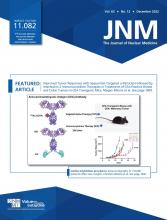Total-body PET and long-axial-field-of-view (LAFOV) PET are game-changing innovations at the threshold of clinical implementation. Early experience has demonstrated high sensitivity (84 cps/kBq), a time-of-flight resolution of 214 ps, and improved image quality enabling ultra-fast or low-dose scanning (1). An LAFOV PET/CT scanner (Siemens Biograph Vision Quadra) was installed at Rigshospitalet in September 2021. This post illustrates how this 10-fold increase in sensitivity can enable avoidance of general anesthesia by fast and flexible PET acquisition. The departmental review board approved this study, and the parents gave written informed consent.
An LAFOV 18F-FDG PET/CT scan was performed on a 17-mo-old girl suspected of having incomplete Kawasaki disease after 12 d of fever despite broad-spectrum antibiotics. Previously, she had undergone left heminephrectomy due to a duplex kidney and repeated urinary tract infections. She had high C-reactive protein, anemia, hypoalbuminemia, and thrombocytosis, as well as relapse of fever despite immunoglobulin therapy and high-dose acetylsalicylic acid. PET/CT was performed to rule out malignancy or focal infection.
The patient was positioned in a vacuum fix pillow supplemented with light fixation across the body using a hook-and-loop belt with arms free. The mother was present during the scan, keeping the toddler calm by singing. The scan was acquired 74 min after injection of 35 MBq of 18F-FDG (3 MBq/kg); low-dose CT was followed by a 5-min PET acquisition in list mode while the patient was observed for movement. An image frame of 120 s with minimal movement was reconstructed using a standard protocol of 4 iterations and 5 subsets, 1.65 × 1.65 mm voxels, and a gaussian postprocessing filter of 2.0 mm in full width at half maximum. The reconstruction method was ordinary Poisson using point-spread modeling and time of flight with a maximum ring distance of 85. The images were of good quality for interpretation despite slight misalignment over the extremities.
PET/CT demonstrated no signs of infection or malignancy (Fig. 1). Thus, the patient was discharged. All parameters had normalized at follow-up a week later. This case illustrates how LAFOV PET enables whole-body PET imaging in children without the risks and logistical challenges associated with sedation.
Sagittal (top) and axial (bottom) CT (A), PET (B), and PET/CT (C) images and maximum-intensity-projection reconstruction (D) after 120-s PET acquisition. No pathologic uptake is seen, but there is reactive accumulation in distal part of esophagus (yellow arrow), physiologic thymic uptake (blue arrow), and accumulated urinary activity in diaper (white arrow).
DISCLOSURE
No potential conflict of interest relevant to this article was reported.
Footnotes
Published online Jun. 16, 2022.
- © 2022 by the Society of Nuclear Medicine and Molecular Imaging.
- Received for publication December 7, 2021.
- Revision received June 11, 2022.








